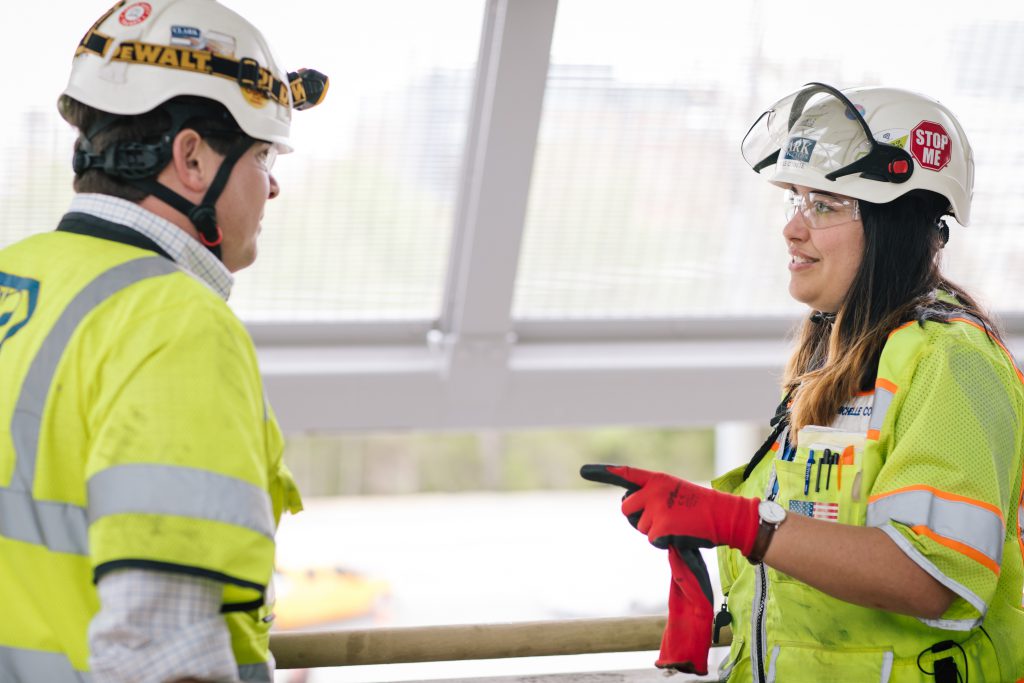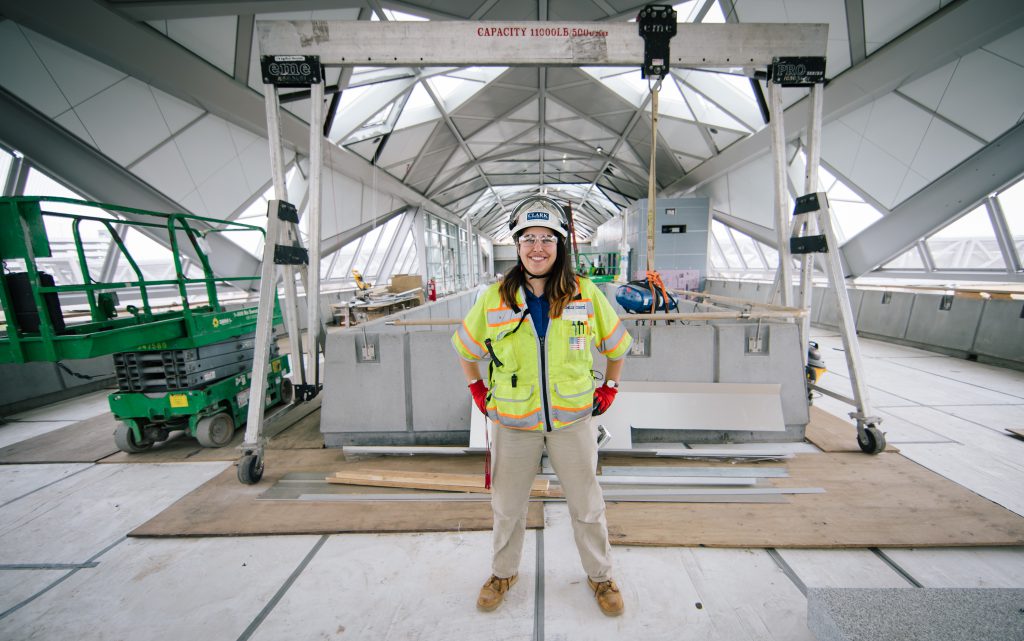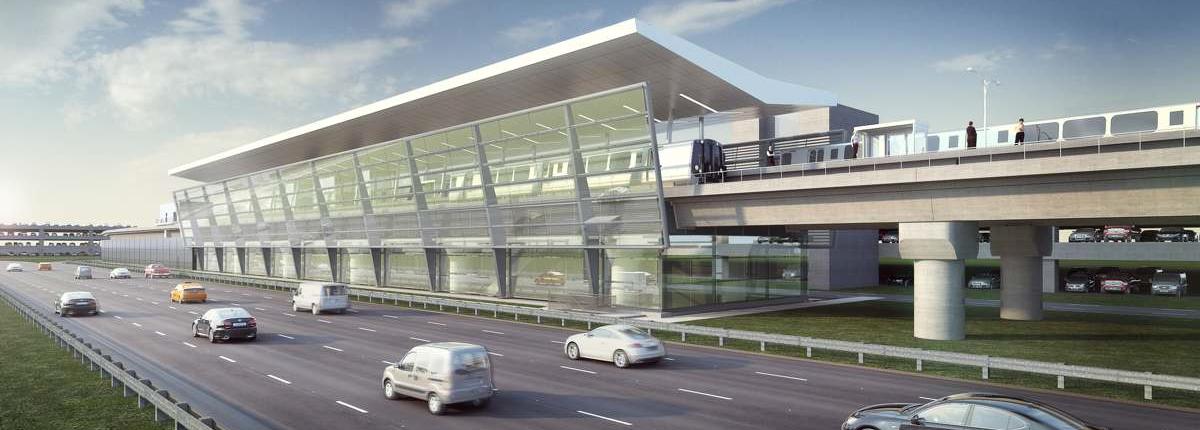For CRC Assistant Superintendent Michelle Cousté, working in the construction industry is her passion. Building sets and running lighting cable while in the theater in school gave her a first taste of the industry and left her hungry for more. With a degree in civil and environmental engineering from Carnegie Mellon University and a member of the CRC team, she is the rare young woman in her field. And now, the 26-year-old native Marylander and current Arlington, Va., resident has found her ultimate role overseeing completion of the Ashburn Station on the Silver Line Phase 2 project. Her perfectionist nature, high standards, and extroverted personality have served her and CRC well as she ensures quality and safety are the first orders of business.
What led you into engineering and construction? I went to an all-girls Catholic school in Kensington, [Md.], and math and science weren’t necessarily our strong suits. Writing was the big focus for the school, so in every class you took you had to write a paper. Even in AP Calculus. The teacher said, “I’m going to have each of you write a report on a type of engineering.” I started reading and writing about what civil engineers did, what the day-to-day looked like, what skills it took, what kind of people did it. And the more I read, the more I thought, “Wait. This is me! This is using math and science skills to problem-solve, to help cities and infrastructure, and you work with a bunch of different types of people because you end up being the liaison between a bunch of different groups.” I did a complete about-face in all of my college search stuff at the end of junior year and started looking at civil engineering. I told my parents about this, and my mom said, “Oh yeah, you’ve always liked construction.” And I said, “What are you talking about?” And she said, “I used to walk you around the neighborhood, and you always cried. But the only time you would get entertained and not cry was when I would pull your stroller up in front of a construction site!”
You’ve always enjoyed process? Yeah. I find it really fascinating how a million little things can come together to make one thing that is complete and usable. One of the most beautiful things to me is watching two very skilled equipment operators work together with big machines to achieve something. It’s like ballet to me.
So you graduated and ended up at Clark Construction? I interned at a different construction company in Pittsburgh, near college. Then I started with the CRC team in August of 2015. I ended up back in this area just because of that opportunity. I have worked for three and a half years on the Silver Line [Phase 2] project.
How did you make your move from the office to the field? I’ve known I wanted to be in the field as a site superintendent since Day 1. I was offered that opportunity about a year ago at the Innovation Station portion of the project. That day was the most enjoyable day I had at working in construction yet – being outside the whole day, meeting a million different people, learning about what was happening and what needed to happen. After three days of being out in the field, everyone above me, and even people working for other companies who I was working with, all went to my boss and were like, “Michelle’s great. You need to keep her out here.”

And now you have moved on from Innovation Station to Ashburn Station. What do you do specifically for CRC now at Ashburn Station? What’s your day look like? I come to our main set of trailers and pick up the truck that’s assigned to me, then I drive to Ashburn Station. I get there about 6 a.m., because that’s when work really starts for the day. First thing in the morning is a good time for me to check on progress and see where things are at, what things did and didn’t get done the day before. At 7 a.m., I have a meeting with all the foremen on the site for the day. One of the most dangerous locations requiring a lot of coordination is the track bed. I go over what’s going on for the day, and safety in general, and specifically for safety in the tracks. Then, those foremen have an opportunity to check in and I make announcements. I am basically coordinating and enabling all of the different trades to do their work for the day.
Getting aligned with those guys laying the concrete and the rebar, the electricians… Yeah, to the people doing the tile, to the people pulling cable for all the fire alarm devices, to the people fire proofing things, to the people building the elevators and escalators. Putting in handrails, putting in metal support beams and ceiling tiles. And walls, drywall and paint, everything. The superintendent is the main go-between that helps coordinate all those groups.
And then what? If we have to move equipment or move materials, I watch while the crews rig it up and use cranes and other equipment, just to make sure they’re doing it safely and correctly. I look at work that is being done, and make sure they’re doing it correctly or that it was done correctly, because I monitor the quality as well as the progress.

What do you like best about working on Silver Line Phase 2? It’s very cool that I’m working on a project that is going to have such a positive impact on so many people’s lives. More people are going to be able to get to Dulles to fly out of there. People out in this area are going to be able to work in D.C. without having to have cars. The public infrastructure aspect of it is very cool, but what I like best out of my experience is the people I have had the opportunity to work with.
Characterize this project… Obviously you view it through the lens of your station, but in terms of safety, how would you characterize it? Is this a really safe work site? Is this a really safe project? This project has a lot of unique challenges to safety, and very strict requirements for safety. It’s an interesting combination of a building and a rail project. When you have work several levels above the ground, there’s safety that goes with that, like any normal building construction. But there are also very specific safety rules when you have a railroad project because the tracks are dangerous. We have a lot of experienced people on the project, and we have a very stringent, robust safety program. There are a lot of specific safety trainings that people are required to go through at different phases of the project to make sure everyone is aware.
What would you like the people who live near the Phase 2 project and who are going to use it to know about all the work that’s gone into it and all the things you’ve done? We’re working hard to integrate this effectively into the community and make it helpful to everyone, not just people who ride the Metro. There are a lot of pedestrian bridges that you can use without having to pay to get onto the Metro train. There’s a lot of site lighting that we’re adding to help areas be more well-lit and therefore safer. We’re doing road improvements as part of it to make sure everything’s well-paved. We’re trying to generally improve the whole area at the same time as adding the Metro.
How will you feel when you drive by that station you’ve been working at or when you ride on the Silver Line, knowing that you had an important role in this project that’s going to last for a lifetime? I’m going to be so proud, honored, and excited to share it with everyone I know! The first time I get to ride out to one of these stations that I worked on with someone, they’re going to be so annoyed, because I’m going to be like, “You see that? I had to figure out how to solve that issue. And do you see that, over there? This has this cool system behind it. You can’t even see because its covered by a panel, but it’s really fascinating!” I’m just going to be so excited to share with everybody how much went into building this, and how proud I am that I had an integral impact in making it happen.
